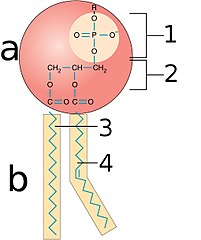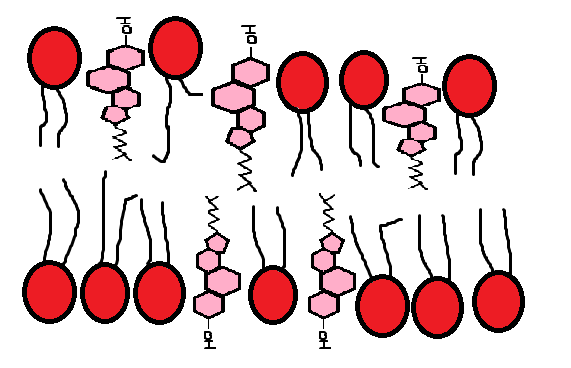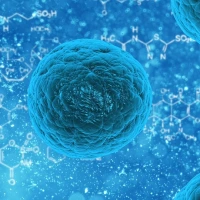What are Factors that Increase or Affect cell Membrane Fluidity?
All cells have cell membranes that form as barriers between the outside extracellular side and the inside of the cell. Cell membranes are fluid, which means they are not always in the same shape. In this lesson, we explain what factors affect or increase the fluidity of the plasma membrane or phospholipid bilayer.

Cell Membrane – Factors that affect cell membrane fluidity – Copyright Moosmosis
What increases membrane fluidity?
In general, shorter tail lengths of phospholipids, more unsaturated phospholipids, and less cholesterol in the cell membrane increases membrane fluidity.
Shorter Tail Lengths of Phospholipids
-
If the length of the phospholipids decreased, then individually, other molecules within the cell membrane, such as transmembrane proteins, can move around more easily inside.
Think of a supermarket aisle. Imagine Person A and Person B. Person A is blocking the aisle path with his standing body, but Person B is blocking the aisle’s width with his body and shopping cart. It is harder to maneuver past Person B than Person A. This is the same idea with phospholipids. A phospholipid that is covering the “aisle” with its longer tail length decreases the overall fluidity or movement of other molecules.

The yellow portion of this diagram indicates the tail ends of a phospholipid. The longer the tails are, the less fluid the cell membrane is. Image Credit: Wikipedia Commons
More Double Bonds or Unsaturated Fat:
The more phospholipids with double bonds, the more fluid the cell membrane is. This is because the double bond provides a kink within a monolayer. This prevents all of the phospholipids from packing together really closely and restricting fluidity of the membrane.
–Cold Environments: More double bonds= Better in Cold Environments
Animals living in freezing temperatures tend to have more unsaturated fat and double-bonded phospholipids in their bodies. When the environment is so cold, the cell membrane can freeze and stop moving, and that is bad. The individual phospholipids, in other words, would pack together so closely and would be more susceptible to “freezing.” Thus, animals adapted to these frigid environments have more double-bonded phospholipids in their cell membranes, due to the double bonds making kinks and spacing out the individual phospholipids from freezing together so closely.
Does cholesterol increase membrane fluidity?
Cholesterol is a rigid molecule that can both decrease and increase membrane fluidity depending on the temperature of the membrane. Temperature can affect the fluidity of a membrane. For example, when the temperature is high, more cholesterol decreases the fluidity of membrane. However, when the temperature is low, cholesterol increases membrane fluidity. We explain the details right below.
- Less Cholesterol: Heads up! This will depend on temperature. More cholesterol in the cell membrane causes the membrane to become more rigid and less permeable to other molecules or ions in high temperatures. However, more cholesterol increases fluidity in low temperatures. Why? In higher temperatures, phospholipids and other cell membrane molecules are already moving wildly (See Section 5: Higher Temperatures). Cholesterol itself is a chunky lad, so its bulky size will restrict the molecule movement within the membrane more. Thus, in high temperatures, more cholesterol decreases fluidity. However, in low temperatures, this is the opposite case. Imagine in cooler temperatures, the molecules are freezing and pack closer together and thus move less. With the presence of cholesterol, like double bonds and unsaturated fat, the tight packing is inhibited more.

Less Packed Together:
This is correlated with the double bonds idea. If the molecules, proteins, and individual phospholipids are packed together so closely, this restricts internal molecule movement within the membrane.
Higher Temperatures:
Remember gas molecules? When the room gets hotter, gas molecules tend to ricochet off things faster. This is the same concept with the cell membrane. Higher temperatures cause an increase of fluidity in the cell membrane.
Summary of Cell Membrane Fluidity and Factors That Affect Cell Membrane Fluidity
Here is a summarized table of the factors that affect cell membrane fluidity:
| Increase Fluidity | Decrease Fluidity |
| Phospholipids with Shorter Tail Lengths | Phospholipids with Longer Tail Lengths |
| More Double Bonds (Unsaturated) | Fewer Double Bonds |
| Less Cholesterol | More Cholesterol (generally in high temperatures) |
| Less Packed Together | Closer Together/ More Packed together |
| High Temperature | Low Temperature |
Cell Membrane Fluidity vs. Flexibility
What is the difference between fluidity and flexibility in terms of biology and cell membranes?
Cell membranes are usually more fluid than flexible. Fluid means that the embedded proteins or carbohydrates attached to the cell membrane have the ability to move around within the membrane. This does not necessarily imply that the cell membrane is flexible. Fluid does not mean flexible. If the cell membrane was flexible, its lipid bilayers would be able to bend easily; however, that is not the case.
For example, cell membranes often contain cholesterol, a hydrophobic molecule that contains a polar head and two non-polar tails. Cholesterol does have the potential to move laterally within a monolayer, but cholesterol is rigid and does not allow the monolayer to be bent easily. Thus, this reinforces the idea that the cell membrane is fluid but not necessarily flexible.
What is the importance of membrane fluidity?
Cell membrane fluidity is important for several important reasons. First, cell membrane fluidity is vital to membrane function and must be regulated and maintained to allow membrane proteins and lipids to diffuse through the bilayer. These proteins and lipids can enter or exit the cell membrane depending on the components of the cell membrane and are essential for synthesis of other nutrient molecules and pathways of the cell. Cell membrane fluidity is also important and maintained because it is vital to the fusion of membranes together and also allows membrane distribution to be split evenly during cytokinesis and cell division. When the cell membrane is too rigid and not fluid, this decreased membrane fluidity can negatively impact transport along the cell membrane and also break under the pressure of the body, such as high blood pressure in arteries. When the cell membrane is too fluid, this increased membrane fluidity can also negatively impact the cell. The cell would be more prone to breaking as well, due to the instability of the cell membrane. The cell won’t keep its shape properly! Therefore, cell membrane fluidity is very important to the homeostasis of the cell and our bodies’ health.
Test your knowledge on <Factors that Affect Membrane Fluidity>.
Questions:
Which of the following factors would tend to increase membrane fluidity?
A. A greater proportion of unsaturated phospholipids
B. A greater proportion of saturated phospholipids
C. A lower temperature
D. A relatively high protein content in the membrane
Answers:
Answer: The answer is A. A greater proportion of unsaturated phospholipids. A greater proportion of unsaturated phospholipids would tend to increase membrane fluidity because unsaturated phospholipids create more space and kinks inside the mosaic model cell membrane. When there are more kinks and space, the unsaturated phospholipids prevent the cell membrane from packing too closely together.
Questions
True or False
- Increasing the length of phospholipid tails inside the cell membrane increases fluidity.
- Decreasing the number of saturated fat inside the cell membrane increases fluidity.
- It is more ideal for animals, living in the Arctic regions, to have more cholesterol in the cell membranes. to increase membrane fluidity.
Answers:
True or False
- False
- True *Tricky! Saturated fat contains single bonds, which would allow phospholipids to pack together too closely. This would restrict cell membrane fluidity. Thus, by decreasing the number of single bonds or making the membrane less packed together, the fluidity increases.
- True ^ See our section above on the effects of temperatures on cell membrane fluidity
Copyright 2018 Moosmosis: All Rights Reserved

If you enjoyed the post, Please feel free to like, share, and subscribe!
Categories: Biology













Thanks just what I was looking for
LikeLiked by 1 person
a perfect material for my exam which is coming soon. I`m 12hr to the exam. Thanks moosmosis crue
LikeLiked by 2 people
You’re welcome! We’re glad this helped. Good luck on your exam!
LikeLiked by 1 person
Thank you thank you for making this! 🙏🏻 I was so so confused about the cholesterol because different sources were saying opposite things. You clarified this concept with the temperature explanation, omg god bless!!
LikeLiked by 1 person
Thank you so much Sheila! We strive to make things easy to understand. We’re glad we helped clarify concepts. Happy learning!
LikeLike
Wow so
easy to understand
LikeLiked by 2 people
Thank you so much, Precious!
LikeLiked by 1 person
Super helpful article on factors that affect cell membrane fluidity! Thanks! 😀
LikeLiked by 2 people
Long time supporter, and thought I’d drop a comment.
Your wordpress site is very sleek 😛
Keep up the good work– and hope you all take care of yourself during the coronavirus
scare!
LikeLiked by 1 person
Thank you Justin for your kind comment! Hope you stay safe and healthy out there too!
LikeLiked by 1 person
For this T/F statement: It is more ideal for animals, living in the Arctic regions, to have more cholesterol in the cell membranes to increase membrane fluidity.
My reasoning is this–> Since the weather is cold in the Arctic regions, normally the cell membranes (absent of cholesterol) would be stiffer or less fluid but adding cholesterol would increase membrane fluidity due to its ability to increase hydrophobic interactions with the phospholipid membrane therefore wouldn’t the statement above be a true statement?
Let me know your thought. Thank you.
LikeLiked by 1 person
You’re absolutely right! Thanks for catching our edit mistake – It looks like our past version got lost during previous article edits – sorry about that! The answer is indeed true, which is also explained in the Temperature section near the middle of the article. Thanks!
LikeLiked by 1 person
Wonderful article and so helpful! It makes everything easy to understand and I learned some great new things today!
LikeLiked by 2 people
hi i would really like to use some of the information in a research project for a level bio but to reference to i need the authors name and when the page was published, i was hoping you could tell me these things. thanks so much
LikeLiked by 1 person
Hi, 🙂 thank you for visiting our site! This article was published on July 7, 2015, made by Moosmosis Organization. You may cite this work with no author designation. Good luck with your research project!
LikeLiked by 1 person